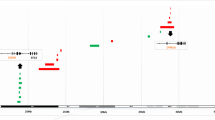Abstract
Purpose
Duane retraction syndrome (DS) is a rare congenital strabismus with genetic heterogeneity. The genetic causes of DS are not always of monogenic origin; various chromosomal copy number variations (CNVs) have also been reported. The objective of our study was to characterize the CNVs, including gains and losses detected by high-resolution chromosomal microarray in patients with DS.
Methods
Twenty patients with DS were investigated using high-resolution chromosomal microarray analysis (CMA) (Affymetrix CytoScan Array 750 K). Conventional cytogenetic analysis was also performed.
Results
All samples revealed normal karyotype by cytogenetic analysis. However, in all our patients, multiple CNVs, including gains and losses, were detected using the high-resolution CMA method. Chromosomal loci 1q21.2, 2p11.2–q11.1, 2q21.1–q21.2, 4p16.1, 7p11.2–q11.21, 14q32.33, 17p11.2–q11.1 and 20p11.1–q11.21 were the most frequently affected regions.
Conclusions
This study emphasized that CNVs in several chromosomal regions are known to be involved in DS. We also underscore the genetic heterogeneity of DS. Our suggestion is that genes located in the most frequently affected regions should be focused on in the following candidate gene studies.



Similar content being viewed by others
REFERENCES
Gutowski NJ (2000) Duane’s syndrome. Eur J Neurol 7(2):145–149
Xia S, Li RL, Li YP, Qian XH, Chong V, Qi J (2014) MRI findings in Duane’s ocular retraction syndrome. Clin Radiol 69(5):e191–e198. https://doi.org/10.1016/j.crad.2013.12.010
Kim JH, Hwang JM (2005) Presence of the abducens nerve according to the type of Duane’s retraction syndrome. Ophthalmology 112(1):109–113
Smith SB, Traboulsi EI (2010) Duane syndrome in the setting of chromosomal duplications. Am J Ophthalmol 150:932–938. https://doi.org/10.1016/j.ajo.2010.06.030
Mehel E, Quére MA, Lavenant F, Pechereau A (1996) Epidemiological and clinical aspects of Stilling-Turk-Duane syndrome. J Fr Ophtalmol 19(8–9):533–542
Gutowski NJ, Chilton JK (2015) The congenital cranial dysinnervation disorders. Arch Dis Child 100(7):678–681. https://doi.org/10.1136/archdischild-2014-307035
Chan WM, Miyake N, Zhu-Tam L, Andrews C, Engle EC (2011) Two novel CHN1 mutations in 2 families with Duane retraction syndrome. Arch Ophthalmol 129(5):649–652. https://doi.org/10.1001/archophthalmol.2011.84
Miyake N, Andrews C, Fan W, He W, Chan WM, Engle EC (2010) CHN1 mutations are not a common cause of sporadic Duane’s retraction syndrome. Am J Med Genet A 152A(1):215–217. https://doi.org/10.1002/ajmg.a.33168
Miyake N, Chilton J, Psatha M, Cheng L, Andrews C, Chan WM et al (2008) Human CHN1 mutations hyperactivate alpha2-chimaerin and cause Duane’s retraction syndrome. Science 321(5890):839–843. https://doi.org/10.1126/science.1156121
Weis A, Bialer MG, Kodsi S (2011) Duane syndrome in association with 48, XXYY karyotype. J AAPOS 15:295–296. https://doi.org/10.1016/j.jaapos.2011.03.007
Chew CK, Foster P, Hurst JA, Salmon JF (1995) Duane’s retraction syndrome associated with chromosome 4q27-31 segment deletion. Am J Ophthalmol 119(6):807–809
Moorhead PS, Nowell PC, Mellman WJ, Battıps DM, Hungerford DA (1960) Chromosome preparation of leukocytes cultured from human peripheral blood. Exp Cell Res 20:613–616
Seabright M (1971) A rapid banding technique for human chromosomes. Lancet 2:971–972
Shaffer LG, Slovak ML, Campbell LJISCN (2009) An international system for human cytogenetic nomenclature: recommendations of the international standing committee on human cytogenetic nomenclature. S. Karger, Basel
Speicher MR, Carter NP (2005) The new cytogenetics: blurring the boundaries with molecular biology. Nat Rev Genet 6(10):782–792
Hochstenbach R, van Binsbergen E, Engelen J, Nieuwint A, Polstra A, Poddighe P et al (2009) Array analysis and karyotyping: workflow consequences based on a retrospective study of 36,325 patients with idiopathic developmental delay in the Netherlands. Eur J Med Genet 52(4):161–169. https://doi.org/10.1016/j.ejmg.2009.03.015
Gonzales PR, Carroll AJ, Korf BR (2016) Overview of clinical cytogenetics. Curr Protoc Hum Genet 89:8.1.1-8.1.13. https://doi.org/10.1002/0471142905.hg0801s89
Levy B, Wapner R (2018) Prenatal diagnosis by chromosomal microarray analysis. Fertil Steril 109(2):201–212. https://doi.org/10.1016/j.fertnstert.2018.01.005
Abu-Amero KK, Kondkar AA, Oystreck DT, Khan AO, Bosley TM (2014) Microdeletions involving chromosomes 12 and 22 associated with syndromic duane retraction syndrome. Ophthalmic Genet 35(3):162–169
Baris HN, Chan WM, Andrews C, Behar DM, Donovan DJ, Morton CC et al (2013) Complex cytogenetic rearrangements at the DURS1 locus in syndromic Duane retraction syndrome. Clin Case Rep. https://doi.org/10.1002/ccr3.11
Lehman AM, Friedman JM, Chai D, Zahir FR, Marra MA, Prisman L et al (2009) A characteristic syndrome associated with microduplication of 8q12, inclusive of CHD7. Eur J Med Genet 52:436–439. https://doi.org/10.1016/j.ejmg.2009.09.006
Forbes BJ, McDonald-McGinn DM, Wootton G, Dawson L, Zackai E, Binenbaum G (2016) Ocular findings associated with chromosome 22q11.2 duplication. JAAPOS 20(3):278–280. https://doi.org/10.1016/j.jaapos.2016.02.003
NBPF14 neuroblastoma breakpoint family member 14 [Homo sapiens (human) ] (2018) Available at: http://www.ncbi.nlm.nih.gov/gene?cmd=Retrieve&dopt=full_report&list_uids=25832. Accessed 4 Mar 2018
HMX1 H6 family homeobox 1 [Homo sapiens (human)] (2018) Available at: http://www.ncbi.nlm.nih.gov/gene/3166. Accessed 11 Mar 2018
Acknowledgements
This study was supported by the Ondokuz Mayis University Research Foundation (PYO.TIP.1901.15.002). The funding organization had no role in the design or conduct of this research.
Author information
Authors and Affiliations
Corresponding author
Ethics declarations
Conflict of interest
The authors report no conflicts of interest. The authors alone are responsible for the content and writing of this article.
Rights and permissions
About this article
Cite this article
Niyaz, L., Tural, S., Eski Yucel, O. et al. Chromosomal microarray analysis of patients with Duane retraction syndrome. Int Ophthalmol 39, 2057–2067 (2019). https://doi.org/10.1007/s10792-018-1042-8
Received:
Accepted:
Published:
Issue Date:
DOI: https://doi.org/10.1007/s10792-018-1042-8




